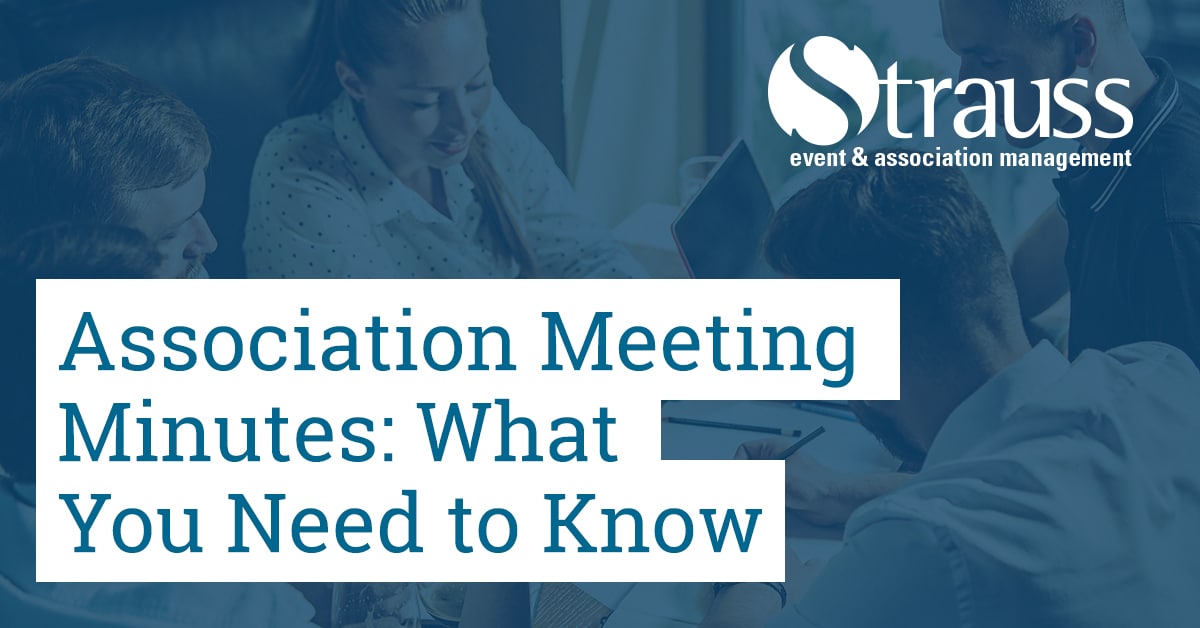Whether you are attending an association Board or committee meeting in person, by conference call or videoconference, meeting minutes need to be taken. The meeting minutes are usually taken by an administrative staff member, the Board secretary or the committee chair.
Meeting minutes serve as an official record of meetings of the Board or committees. They document the Board’s adherence to the proper procedures and the association’s by-laws.
My First Experience Taking Minutes
I remember attending my first association client meeting where I had to take meeting minutes. As I had never taken minutes before, I have to say I was quite nervous about not missing any of the important information. To make sure I was aware of what was going to be discussed at the meeting, I reviewed past minutes, as well as the agenda.
During the meeting, I sat there typing away, making sure to catch everything that was being said. After the meeting was finished, I had three pages of notes, which I then had to go through and review and edit. After editing I asked a colleague who usually sits in on the meetings to review my minutes, and that’s when I learned that I was taking too many notes, and most of the information did not actually need to be documented. It took me a few meetings to figure out how to take good, concise minutes, but now I can say that I am confident in my ability to do this.
What Should be Included in the Meeting Minutes?
If you are new to taking minutes, it can be difficult to figure out what to include. I’ve put together a list of items that should be included in your meeting minutes below:
- Type of meeting – Board Meeting, Program Committee Meeting, etc.
- Location of meeting – For example, in-person in the main boardroom; via conference call or video conference
- Date of the meeting
- Names of the meeting participants, absentees, and staff members
- Time the meeting was called to order
- Corrections and amendments to previous meeting minutes
- Additions to the current agenda
- Motions that were taken. Name of member who put forward the motion and seconded the motion, and the outcome of the vote – approved/declined or tabled
- Actions taken or to be taken
- Items to be discussed at upcoming meeting(s)
- New business
- Next meeting date and time
- Time of adjournment
Taking the Minutes
Now that you have a check list of what to include in the meeting minutes, you have the task of taking the minutes. If you have the option of bringing a laptop to the meeting, I would highly recommend it over doing handwritten minutes in a notebook. Here are 10 tips to help make minute-taking easier and more efficient:
- Use previous meeting minutes as a template, as the format of meeting minutes vary from each association.
- Record participants as they enter the room.
- For conference call meetings have the meeting chair do a roll call right before the meeting is called to order.
- Record decisions on action items as soon as they occur to be sure you are recording them accurately.
- Ask for clarification if necessary. Sometimes there can be a lot of discussion around an item or on a motion, so it is important to ask for clarification on the item(s). If it is a motion that is being discussed and/or changed numerous times, it is a good idea to read out what you have written to make sure it is correct.
- Do not go into too many details (unless the Board requests you to do so). The minutes should reflect the results of decisions. This was my mistake when I first started minute-taking.
- Use a bold font to indicate action plans and who will serve as the lead for each item. For example: Action: Jen Kowaluk to email all members event information.
- For conference call meetings make sure that you are recording the call. This is a great back up for taking minutes, as sometimes it is difficult to hear everyone correctly over the phone.
- After the meeting, review/edit the minutes within 24 hours to make sure what was discussed is still fresh in your mind.
- Have the draft minutes reviewed and approved by the meeting chair and send out to meeting participants within one or two weeks of the meeting.
You can use your finalized meeting minutes as a guideline to prepare the agenda for the next Board or committee meeting. For tips on how to create an agenda for a successful association meeting, click here.
Good minutes are concise and to the point, but at the same time, they do not leave out critical information. I hope that the above tools and tips will help you the next time you are tasked with taking meeting minutes at your association Board or committee meeting.
For more on preparing for association meetings, read some of my colleagues’ previous articles:
Preparing for Meetings Held During an Association’s Annual Conference
My First In-Person Association Board Meeting
The Board Meeting Menu: Tips on How to Create a Streamlined Agenda for a Successful Association Board Meeting.

